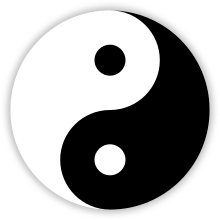Wu Kung-tsao
Wu Kung-tsao (1902 – 1983), also spelled Wu Gongzao or Ng Gung Jou, was a Chinese tai chi chuan teacher of Manchu ancestry known for his literary contributions to and commentary on the tai chi classics in a general sense as well as describing unique characteristics of his family's Wu style tai chi chuan. He was the second son of Wu Chien-ch’uan (Wu Jianquan) and father of Wu Ta-hsin (Wu Daxin).
Quotes
[edit]Wu Family T'ai Chi Ch'uan (1980)
[edit](吳家太極拳), Hong Kong, 1980 (originally published in Changsha, 1935)
- Tai chi chuan (taìjíqúan) is a Taoist practice emphasizing cultivation of martial ethics.

- Tai chi (taìjí) is the universal principle behind birth and transformation. Though tai chi has no form, shape, sound nor colour; all forms, shapes sounds and colours are born and transformed through it. … And so tai chi simply refers to stillness and movement, while yīn and yáng refer to tai chi.
...
In tai chi chuan, because the principles are based on the transformation of tai chi (taìjí) - movement and stillness, yīn and yáng as well as opening and closing - one seeks stillness in movement and movement in stillness. Movement is primarily a study of empty and full, which refer back to yīn and yáng. Students should first know about the principles of stillness and movement in yīn and yáng before proceeding with their studies.
- The body is divided into three parts and nine sections. The three parts are the spine, the two arms and the two legs.
1. Spine: the head, thorax and abdomen. These three sections make up the main trunk of the body.
2. Arms: the hands, elbows and shoulders. These three sections constitute the upper limbs.
3. Legs: the hips, knees and feet. These three sections constitute the body’s lower limbs.So the body is divided into upper, middle and lower vessels. The upper is from the chest and arms upwards, the middle constitutes waist and hips, and the lower vessel is from the thighs and knees downwards.
- Push hands is practiced between two people: the intitiator and the one acted upon. Initiating is called ‘asking’. The person acted upon ‘answers’. When the opponent asks, listen first before answering.
- In tai chi chuan there is basic standing push hands, forward-backward push hands, dà lǜ and nine palace push hands, etc. In his later years, my older brother, Wu Kung-i (Wu Gongyi), created new techniques in applications. … The dà lǜ method of stepping is also called ‘eight gates and five steps’ (bā mén wǔ bù).
- There are six methods of winding silk energy: inner, outer, upper, lower, forward and backward. They are applied from anywhere on the body: the arms. legs, hips and waist, with the body moving continuously, with endless circularity, wrapped together like intertwined filaments of silk.
- Those with hard temperaments like to win through struggle; they don't like to be defeated. Inferior hard temperaments are explosive and rash, fierce and violent. Soft temperaments are placid and earnest. Inferior soft temperaments are weak-willed and do not seek a thorough understanding of the skills. Tai chi chuan stresses that hardness and softness complement each other. Training teaches one to be hard, but not excessively so, soft, yet not weak. This is to truly absorb the teachings.
Those with soft temperaments easily improve. Those with inferior hard temperaments always mistake slowness and lack of force for sluggishness and weakness. Actually, slowness and forcelessness are fundamental aspects of training. Just as steel is produced by applying heat to iron, tempering it, skills of tai chi chuan are refined gradually over a long time.

